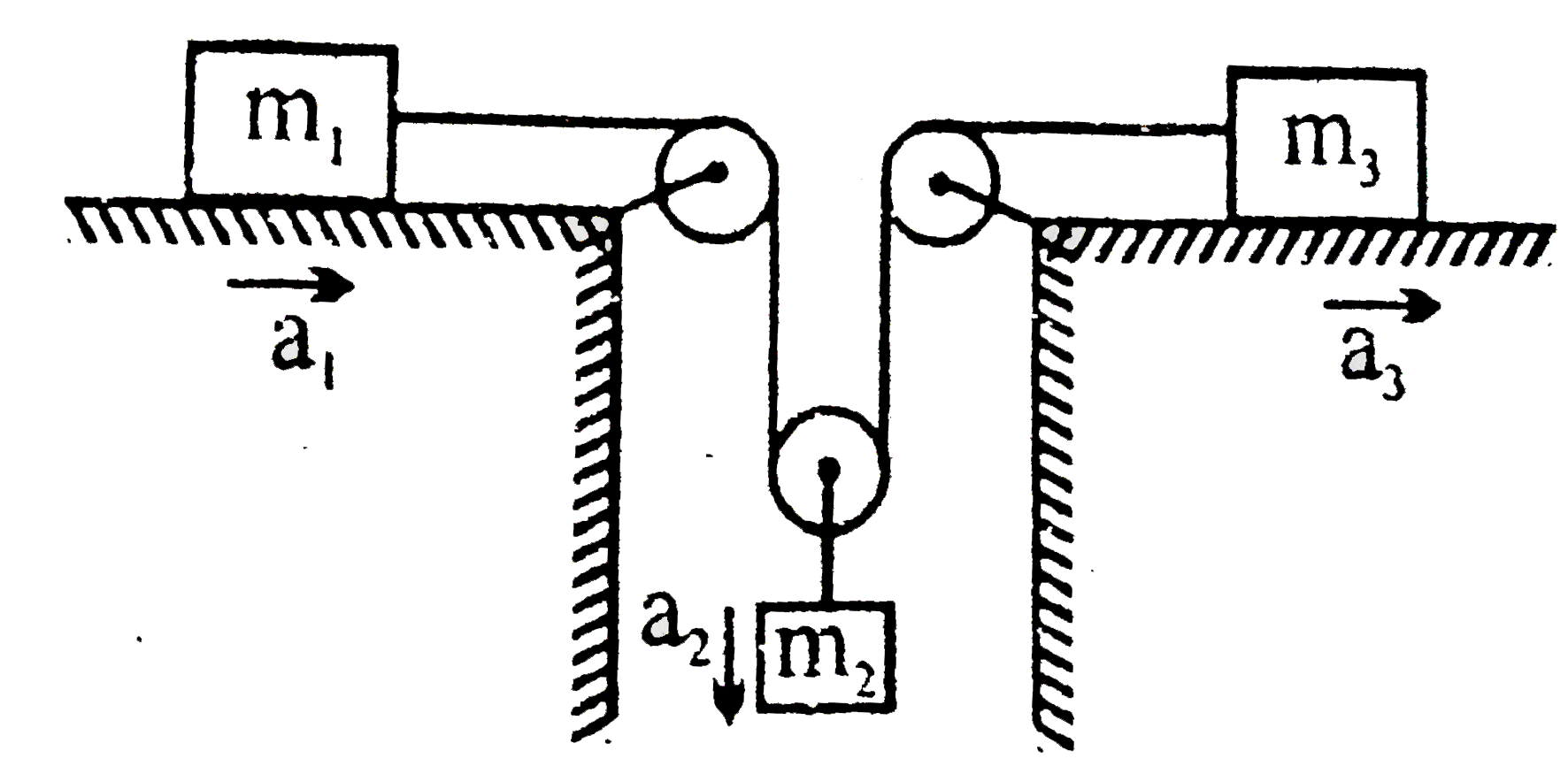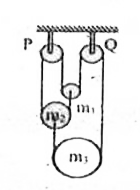In the figure, m1 is at rest, find the relation among m1,m2 and m3 ? .
m1 is rest ⇒ point B3 does not move, m2 and m3 move with accelertion
a=(m3−m2m2+m3)g,m3>m2
T=2m2m3gm2+m3,T1=2T=4m2m3gm2+m3
m_(1) cancelg =(4m_(2)m_(3)cancelg)/(m_(2)+m_(3)) , 4/(m_(1)) = 1/(m_(2)) + (1)/(m_(3))
 .
.
Topper's Solved these Questions
- NEWTONS LAWS OF MOTIONBOOK - NARAYNACHAPTER - NEWTONS LAWS OF MOTIONEXERCISE - C.U.Q
73 Videos
- NEWTONS LAWS OF MOTIONBOOK - NARAYNACHAPTER - NEWTONS LAWS OF MOTIONEXERCISE - LEVEL -I (C.W)
47 Videos
- MOTION IN A STRAIGHT LINEBOOK - NARAYNACHAPTER - MOTION IN A STRAIGHT LINEEXERCISE - Level 2 H.W
29 Videos
- OSCILLATIONSBOOK - NARAYNACHAPTER - OSCILLATIONSEXERCISE - EXERCISE - IV
41 Videos
Similar Questions
Knowledge Check
In the pulley system shown here, find the relationship between acceleration of m1,m2 and m3
 A2a1+a3+a1=0B2a2−a3+a1=0C2a2+a3−a1=0D2a2−a3−a1=0
A2a1+a3+a1=0B2a2−a3+a1=0C2a2+a3−a1=0D2a2−a3−a1=0In the adjacent figure, all the pulleys are frictioniess and massless, all the stringes are also massless. The relation between a1,a2 and a3 is (where a1,a2 and a3 are the acceleration of masses m1,m2 and m3 respectively in the direction as shown in the figure)
 Aa3−a2+2a1=0Ba3+a2−2a1=0C2a2+a3=2n1DNone of these
Aa3−a2+2a1=0Ba3+a2−2a1=0C2a2+a3=2n1DNone of theseA pulley-block arrangement is shown in the adjacent figure, if acceleration of m1,m2 and m3 are a1,a2 and a3 respectively, then relation between a1,a2 and a3 is ( All string and pulleys are ideal . )
 Aa2−a3+10a1=0Ba3−a2+10a1=0Ca2−2a3+10a1=0D2a2+a3+5a1=0
Aa2−a3+10a1=0Ba3−a2+10a1=0Ca2−2a3+10a1=0D2a2+a3+5a1=0
Two bodies of masses m1 and m2 are moving with velocities 1ms−1 and 3ms−1 respectively in opposite directions. If the bodies undergo one dimensional elastic collision, the body of mass m1 comes to rest. Find the ration of m1 and m2.
View SolutionLet m1=1kg, m2=2kg and m3=3kg in figure (5-E12).Find the accelerations of m1,m2 and m3 .The string from the upper pulley to m1 is 20cm when the system is released from rest.How long will it take before m1strikes the pulley?
View SolutionMass m1 hits & sticks with m2 while sliding horizontally with velocity v along the common line of centres of the three equal masses (m1=m2=m3=m). Initially masses m2 and m3 are stationary and the spring is unstretched. Find
(a) the velocities of m1,m2 and m3 immediately after impact.
(b) the maximum kinetic energy of m3.
(c) the minimum kinetic energy of m2.
(d) the maximum compression of the spring.

View SolutionFind the torque on M1 due to M2
View SolutionShown in the figure is a system of three bodies of mass m1,m2&m3 connected by a single inextensible light string. If all surfaces in contact are smooth & the pulleys P & Q are light, find the tension in the string.

View Solution


 .
.